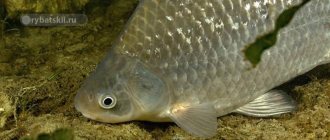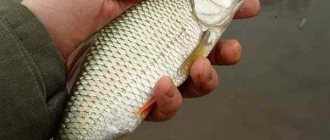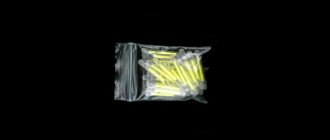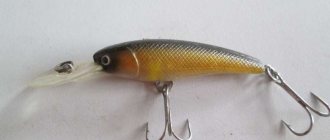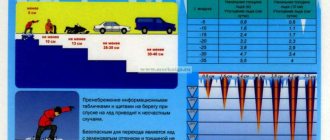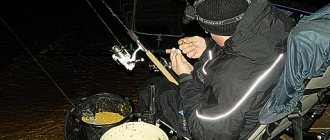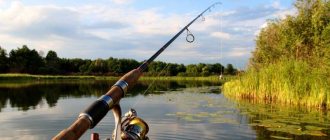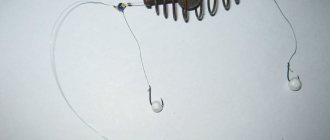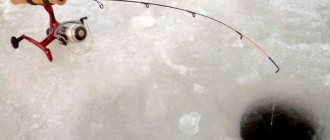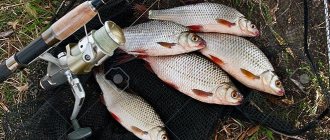Catching roach on a feeder is interesting and relevant for most novice feeder anglers. Moreover, it’s spring now; this beautiful fish is most active at this time.
Let's start with the appearance of this agile fish. The roach has a short body length, but in some reservoirs and locations you can run into a decent bonus. More often found in catches from 10 to 40 centimeters. Various sources indicate the maximum size of caught roach to be 71 centimeters. The scales of roaches are not small; they greatly depend on the size of the fish. Roaches have bright orange, reddish eyes .
Novice fishermen often confuse this fish with rudd, but this should not be done. I think fish should be known, especially since they are not some kind of exotic fish.
Where does it live?
Roach is very common and is found everywhere. I caught it both in still water and in large rivers. Loves plenty of oxygen and shallow depths. The depth is only necessary for wintering. I haven’t caught large roaches in stagnant bodies of water; they are mostly small in ponds, lakes, and reservoirs. Although once I got to the distribution of “loaves” on the Yauza. Large specimens are found in the river much more often.
It was not possible to catch very large specimens, but roaches weighing 400–500 grams were caught. I fish in the Kaluga and Tula regions. You can catch good roach in the Kaluga region on the rivers: Oka, Zhizdra, Ugra, Protva, Zhelov. From standing reservoirs, I would look at: Lake Rezvan, Andreevsky quarry, Lake Vyrka, also sometimes found on the Yachensky reservoir, but not in large quantities. In the Tula region, I caught roach only on the Upa River and Lake Goryachka. The Upa is an interesting river, a lot of fish and its size is sometimes amazing, it’s a pity that I can’t go there as often as I want, but my native Oka is enough.
Where to look for roach in September
At the beginning of autumn, roaches can still peck at their usual summer spots. This is especially true for warm bodies of water.
With the appearance of the first yellow leaves on the trees, the fish begin to gather in large schools. At this time, the water becomes clear and its temperature drops. Roaches move from the channel edges into deep backwaters. There, the fish continue to actively feed near the flooded snags, on the edge of bottom holes free of vegetation. Promising fishing spots are pools behind rifts, areas below dams, steep banks with trees hanging over the water. It’s good if there is at least a small sandy beach nearby.
In September it is better to catch roach in cloudy weather: in dark water the fish are less timid.
If the month turns out to be inclement, the fishermen are lucky. Rain and gusty winds are ideal conditions for hunting trophy roach. In slushy weather, solid fish rise from the holes and approach the shore for feeding. It can be found at a depth of no more than 1.5 meters. Roaches usually stand in places where the water begins to darken.
It is curious that this behavior is characteristic only of the large sorog. Small and medium-sized specimens still stand in pits up to 4 m deep during bad weather in September.
Rod selection
Let's talk about feeder rods for catching roach. Let's divide our fishing into two types, take into account fishing on the river and fishing on a standing reservoir separately. On a large river you will need a feeder rod with a test rod suitable for the strength of the current. The height of the rod is selected individually, a rod with a height of 3.6 meters will be universal, for long casts it is worth looking at a feeder with a height of 3.9 meters. It is not always worth looking for roach on a strong current; I have had cases when I caught this red-eyed fish right under the shore on a large river, then I actively used gear for standing reservoirs, because the current was minimal or completely absent.
For lakes and ponds, you will need more delicate rods. I prefer to use picker rods. I get maximum pleasure from such fishing, especially when roach is actively caught. When fishing with picker rods, there is one difficulty. Due to the small size of the feeder, casting further than 30 meters is problematic. Here you will need a Medium class “stick” for fishing at medium distances, for example, up to 50 meters. On reservoirs, you sometimes have to use long-range sticks to fish at long ranges. You won’t guess where this nimble fish is at the moment.
Feeder equipment for roach
Often you have to catch roach in competitive mode. Therefore, my favorite feeder rig is “Running Feeder Rig” or “Inline”. These are two almost identical installations, their essence lies in the safe “exit” of the fish if the entire installation breaks at once, in case of emergency. The installation is sliding and gives good sensitivity and delicacy to the gear. When using any installation, I recommend installing an outlet under the feeder and a leash. An outlet made of fluorocarbon or thicker fishing line is suitable for the feeder. For retraction under the leash, when fishing with thin leashes, you should think about an insert made of beaded rubber and feedergam.
I can also offer another option for installing feeder gear, the long-loved Paternoster. Thanks to the right large loop, it will be possible to slightly retain the bait in the thickness or bottom layer, which increases the chance of catching this beast, if, of course, roach is present at the point and does not behave passively. Paternoster installation is simple and it’s easy to tie it directly on a pond, the main thing is to practice.
Cord or fishing line
The choice between cord and monofilament line as a base. The issue is controversial and ambiguous, so I’ll tell you what I think about it. I often use monofilament line as a base, but it is only good for fishing at short distances of 15–20 meters. Due to the stretchability, the bites come with a slight delay and you can miss the moment of hooking, but if you get used to it, it won’t hurt you at all. I love fishing with a fishing line, at first it was uneasy, but then everything fell into place. If we are talking about distant frontiers, then we choose a braided cord. We conclude that when fishing for roach, there is no preference in the main material of fishing line or cord, with the exception of fishing distance.
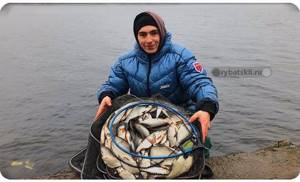
If you are going to fish with a fishing line, choose a feeder line rather than a regular one. The feeder line stretches less and will be relevant when catching any fish. An ordinary monofilament line will be relevant only when fishing for carp, often for large specimens. I recommend a black feeder line - Dunaev Feeder Match.
Where is autumn roach caught?
At the end of October and November, roach schools gather in deeper holes and in the riverbed zone. In reservoirs, the roach moves further and further from the shore. Fishermen have to cast gear at a distance of 60 meters and further. On rivers, roach most often occupies secluded places behind the first or second edge at depths of 4 to 7 meters.
If in summer it could easily be caught in areas with a depth of 3 to 4 meters, then in late autumn it is problematic to catch roach in these same areas. This is due to the fact that shallow and not very deep places cool faster, and the roach tends to leave these places and moves to depth. In deep holes and on the lower edges, the water temperature is several degrees higher than in the upper and middle horizons.
Taking into account all of the above, the angler must clearly know the bottom topography and look for the deepest areas in the reservoir. For example, two weeks ago roach was caught perfectly in a fairly wide area. It could be a reach, an area of the first edge, a coastal dump. You could choose any point, and at each of them, if you pre-fed, you could catch a roach. But as the temperature drops, these points gradually “die off”, and roach ceases to be as well caught as before. The promising zone in terms of catching roach is significantly reduced.
If you take a map of the depths of any section of the river, then the emphasis should be on areas with depths from 5 to 7 meters:

Areas with snags are considered promising places. There's still plenty of fish food there. It is worth considering that at this time the food supply in the form of animal and plant food is decreasing. Many larvae and worms burrow into the mud. The main food of roaches is bloodworms. It is most found in muddy areas of the bottom. It is most often caught in the fall.
The fisherman will be very lucky if he finds a steep bank, behind which the depth increases sharply. If the current in a given place is small and the edge is nearby, then the need for long casts disappears. Often schools of roach are located at the border of silt and shells. In general, at this time it is very important to find this border. At the beginning of fishing, you should tap the bottom with a weight and determine where the silt ends and where the sandy bottom or shell begins.
Of course, success in roach fishing comes to those who know how to choose the right place and find deep areas of reservoirs. If in the summer you can catch roach in almost any place and there will be bites, provided the bait is correct, even if not so frequent, then in late autumn everything is not so. If you choose the wrong place, you may not see a single bite. And in this case, proper bait and selected bloodworms will no longer help. If the roach does not visit these areas, then it will not come this time either.
What kind of leash should I use?
Let's look at the selection of leashes for roach fishing. The leash plays an important role in this fishing. The roach usually stands in the bottom layer, which means that you need to make a smooth animation of the bait as it falls. It is precisely at this moment that the roach attacks in its active state. Unfortunately, this does not always happen; fish can also actively feed from the bottom. There is no clear idea of where the fish are currently feeding. Check this point during the fishing process, experiment with the leash and hook for the feeder.
I think when fishing for roach, a light hook is important, and it’s also worth choosing a combination of bait to ensure good results.
Start fishing with a meter-long leader made of thin-diameter fishing line, and then you will see. It may be worth lengthening or, conversely, shortening the leash for indistinct poking and sucking of the bait. When fishing for roach on the feeder, I use Owner 53101 hooks in numbers 18.16; these hooks have a red coating, which makes the bait stand out. The fishing line is suitable in diameters from 0.07 to 0.12 mm, depending on the activity and size of this red-eyed fish.
Bream
In early September, bream can be caught at the border with vegetation, where the bottom is muddy. Bream at the beginning of September still takes vegetable bait. But already in October, bream begins to move to winter places, to wintering pits. Movement routes change depending on autumn weather conditions, so they are very difficult to determine. Since summer is almost over, massive starting complementary feeding is not needed. In the fall, the far and near points are fed. For points, take different baits, for example, millet with maggots and peas with chopped worms. To give the complementary foods a dark color, mix clay or soil from a pond. In November, bream almost never approaches the coastline. It lives at medium and deep depths. It is better to catch it on a rocky and clay bottom. On the sandy in November, bream will be caught worse. The bait for bream in November is bloodworms or maggots. In complementary feeding in the fall, smaller fractions are used. For example, millet and ground crackers are used as the base component. Roasted seeds or cake, bloodworms and a flavoring agent, for example, vanillin, are added to this base for flavor. Also an obligatory component is clay or earth.
Look at the video of how to catch bream using a feeder:
Feeders
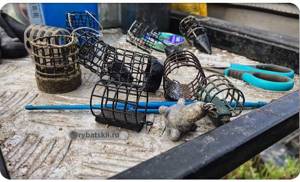
I would recommend feeders with a small feed capacity, but you shouldn’t stay too long at the point. Thimbles are perfect for catching small roach. Keep throwing it around and the fish will definitely come. Don’t shy away from various flavoring additives; I like dry additives from the French ones called “Gardons” or “Rotaugen”.
Bait and its combinations
When a roach is active, it takes everything it sees into its mouth. In warm water, any bait will be relevant: maggot, worm, bloodworm, pearl barley, wheat, corn. If we are talking about feeder fishing in early spring or late autumn, then pay more attention to bait of animal origin, and in particular, to bloodworms. Combinations of maggots + bloodworms, as well as bloodworms (in a stocking or ring, in the middle) help well.
When fishing with maggots, if the bite is bad, try cutting the butt of the white larva with scissors; an enzyme from the maggot will be released in the water, which makes it bite on the bait.
Barley and wheat will be relevant only in warm water, May - September. Or on warm reservoirs all year round, for example the Desnogorsk reservoir. When feeder fishing for roach on corn, bites will be less frequent, but the size of the fish will increase if there is a large roach at the point. All winter I successfully caught large roach on the Desnogorsk Reservoir, including using corn. An excellent reservoir, it helped me scratch the “winter itch” and have a blast with the most beautiful roach.
Fishing places
- Its favorite places to stop are quiet, slightly overgrown bays with depths of one meter or more.
- It is also worth looking in shallow holes located near steep banks.
- In addition, you can find it at the borders of reeds and clear water.
Catching roach in the fall is fundamentally different from the fishing that could be successful in the summer. At this time, it moves little around the reservoir, reacting only to the nozzle that is in close proximity.
The fishing process itself involves constant movement, in search of schools of fish. Having discovered it, we catch it until the bites stop completely, then we look for another place, then a third. After some time, it makes sense to return to your previous fishing spots; with a high probability, the roach will be there again.
Lures and groundbait
Fishing with baits of plant origin is practically pointless; it is caught with them extremely reluctantly, and even then in rare cases. The best bait for autumn roach fishing is bloodworms; worms and maggots are inferior to it in terms of catchability. Maggot is ideal in cases where there is a large amount of small fish at the fishing site, since when fishing with other baits, it will not leave the angler alone.
Roach can also be caught quite well with caddis flies, and experienced fishermen catch it with the meat of shells, gently playing with the bait near the very bottom. The bite is very careful, so you should be careful and react to even the slightest vibrations of the float.
As for the bait, it should consist of small particles - chopped bloodworms mixed with chopped maggots and rolled into earthen balls. Powdered eggs, milk powder and roasted peanuts are suitable additions. At the same time, also try to use a minimum amount of various oils and flavors, since in the fall they are more likely to scare away the fish.
The best weather for fishing is quiet, windless days; the bite begins as soon as the water warms up a little and continues throughout the day.
Bait and its role in catching roach
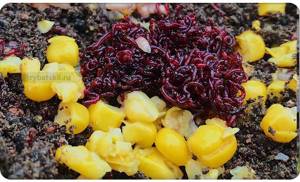
With feeder bait for roach it will be a little more difficult; you need to understand its meaning and the mechanics of its work. The roach loves it when the point is boiling, when there is movement there, when food particles float up and down. This attracts her from a distance. This doesn’t always happen; I’ve had fishing trips when roaches responded to inert and heavy food. Roach also becomes a frequent guest when fishing for other fish, but now we are only interested in targeted roach fishing.
Look at the packs with the name “Roach”. From aromatics, pay attention to sweet smells: Vanilla, Chocolate, Biscuit, Roach. Please note that I said about concentrates, do not confuse them with Aroma-Complexes. Concentrates do not change the mechanics of the feed, but only supplement and enrich it. Of the components in the form of an additive, use Copr-Molasses, this additive attracts roaches. Copra is coconut shavings soaked in molasses, a dizzying smell.
Also try adding a live component to the bait composition with plugs, namely feed bloodworms, maggots in different states of aggregation, and chopped corn. I also like the work of store-bought canned hemp, it’s a great thing, I add it in whole grains, and also sometimes cut it into porridge. The smell is just a bomb, all fish will appreciate it, including our beloved roach.
The main thing is to experiment, I have said many times that there is nothing exact in fishing. As they say, patience and work, and everything will definitely work out.
Catching roach on a feeder in winter
Anglers have this tendency to form schools. You can show off yourself in a crowd, learn from others, and just have fun in the fresh air among your fellow hobbyists. After carefully observing such a group of anglers, you will probably find that only a few individuals are really good at fishing here, the rest are content with rare bites, or even sit with “zero”.
All of the above fully applies to feeder fishing, which has been gaining momentum in recent years, becoming a truly popular type of fishing. As a feeder athlete, I have more than once found myself in a situation where neighbors came up to me on the shore and asked why I was “hungry,” but they hadn’t even seen a bite in half a day. And sometimes they ask me about something directly, for example, what number of hook I use, what thickness of fishing line, they ask me to tell me how to mix the bait correctly...
I willingly talk about what I know, about equipment, bait, and simply about my observations of the behavior of fish. When the person fishing in the neighborhood also begins to drag the fish, he becomes a good, kind interlocutor, and not a “grandfather” grumbling under his breath, begins to exude positive vibes - and as a result, everyone around him feels good.
Many misconceptions and incorrect actions on the part of beginning feeder lovers are associated with winter fishing for river roach. I would like to share some of my thoughts on this matter today. Let's try to sort everything out without missing out on the small details, because the nuances usually make up a good catch.
Let's look at feeder fishing using a specific example - on one of my recent trips to the lower Moscow River. I didn’t specifically look for solitude on the river, but chose a place that was very popular with local and visiting fishermen - not far from the village of Chulkovo, so that it would be more clear.
So, first things first
Experienced fishermen know that the winter habits of roaches are fundamentally different from the summer ones. You need to look for winter roach on the river in places such as exits from holes, shallow rapids, rifts and areas beyond rifts. The bottom in the roach fishing areas should be hard: pebbles or shells.
But it happens that when “probing” the soil with a marker sinker tied on a braided fishing line, you feel a hard rocky or shell bottom everywhere, and suddenly you find yourself on a 1-2-meter strip of silt. This anomaly is the very place where you should first try to catch!
But it happens the other way around: the entire bottom is completely muddy, and among this mud it is possible to find only a small patch of shell or small stone. He, too, should receive your close attention.
My favorite roach areas of the river are the exits from the pits, where the largest concentration of roach is. This happens because the river current washes out of the pit a whole trail of small edible particles and various microorganisms that provide food for winter roach.
This is the point I chose for my demonstration fishing. However, a holy place is never empty, and on the shore not far from me sat a dozen more fans of the winter feeder.
I always darken the bait in winter, painting it a color closer to black or the color of the bottom in the place of upcoming fishing. For this I use special paint for bait mixtures.
There are different opinions on this matter. Some feeder fans believe that fish are not as afraid of light spots of bait on a dark bottom as is commonly said. But I still paint, because I am sure that in winter crystal-clear water, light spots of bait on the bottom will, if not cause panic, then at least alert the fish, and we are now trying to ensure that no small details could interfere with fishing.
Read: Feeder on the current
The composition of bait for catching roach should include finely ground ingredients. To improve the bite, I always add live ingredients - small food bloodworms and medium-sized maggots.
The composition of the bait for this day I chose as follows: 2 bags (1 kg each) of the Roach bait, a bag (400 g) of the Grilled Hemp additive, a bag (400 g) of the White Fish additive and half a bag (200 g) of the additive "Yellow crackers." To this mixture we add 0.5 kg of small food bloodworms and 0.5 liters of medium-sized maggots, and we will have an excellent winter feeder bait for roaches.
This bait itself has a distinct smell of hemp. A small amount of active particles, entering the fishing point, creates a light fragrant trail downstream, thereby attracting roaches. But the bulk of the bait delivered by the feeder to the fishing point should be relatively heavy and lie on the point for some time.
The bait I chose just meets these requirements. Additives are needed to give the bait additional taste and nutritional properties. For example, the “Yellow Crackers” additive, once at the fishing point, complements the mixture of active small bait particles with its volume and lightness, which is especially good at attracting roach from a distance.
Well, the most important “secret” of roach bait is the “Grilled Hemp” additive, which affects the roach like valerian on a cat. I think this scent is one of the best. On sale now you can find many different flavors for catching roach, but some of them do not work at all, others are very narrowly specialized, that is, they work in one body of water, but are useless in another. And roasted hemp is the most universal dam attraction.
The living component in the form of maggots and small bloodworms also attracts fish well, and not just roaches. Bloodworms are the natural food source for many fish species in winter, and roach is no exception. There have been cases where, without the addition of small bloodworms, the roach generally refused to stand at the fishing point and pecked in some kind of raids.
But maggots are needed in bait only if you intend to fish with them. And since I often get very good dam bites on maggots, I often use it as a bait, which means it should be present in the bait.
To catch roach, I use medium and small sized feeders. At a good fishing pace, the bait placed in them will be quite enough to keep the fish on the point. You can use any type of feeder - either metal mesh or plastic with wings.
There is one nuance here: usually the weight of the feeder is selected so that it lies motionless in the current. And for catching roach, you and I must select a feeder of such weight that it is slightly dragged by the current during the fishing process after it is freed from the bait. Usually the bait leaves the feeder 20-30 seconds after it falls to the bottom. If after this time the feeder begins to roll under the influence of the jet, but not much, but only periodically, breaking off and immediately catching again in a new place, then its weight for catching roach is selected correctly. As we have already said, the roach responds to a moving bait and does not make you wait for a bite.
I usually use two types of rigs - either a paternoster (blind rig) or an “asymmetrical loop” (sliding rig). When fishing for roach, the difference between them is insignificant, but it still exists. The rule here is this: if there is a main monofilament line on the feeder or the roach bites are very weak and accurate, then you definitely need to use an “asymmetrical loop”. And if there is a braided line or everything is fine with bites, then it is better to use a paternoster - it often leads to self-hooking after a strong bite. This equipment is prohibited at international feeder competitions, but we are talking about amateur fishing now.
Read: Catching a goat and a devil
Much in winter feeder fishing depends on the air temperature: if it’s plus outside, I try to fish with a line, it’s more informative. Well, if it’s frosty, even slightly, then only mono-line is used - it freezes less to the feeder rings. Now the air temperature is getting higher every day, and I feel free to use braided fishing line when fishing.
Now a few words about leashes. Usually, when catching roach, I use “giant” leashes - from 1 to 2 m long. With a very good bite, a meter leash is quite suitable, but if the pauses between bites have increased, do not hesitate to set 1.5 m - you will see how the bites will come back to you again . If the fish is completely capricious, then a two-meter leash will be just right. I use two-meter ones very rarely - it was only a couple of times at competitions, when it was important to catch at least something...
I use a leader line no thicker than 0.09-0.10 mm. The thicker the lead line, the fewer bites - you need to know this like “Our Father”.
The same principle applies to hooks: if the winter roach bite is good, then you can safely use N14 hooks. If it’s a little worse, you need to switch to No. 16-18. It is better to use hooks with a spatula at the end and made of thin wire.
Usually these are bloodworms and maggots. For myself, I developed a certain algorithm based on the number of larvae on a hook.
Depending on the situation and the reservoir, roach can respond well to both a couple of bloodworm larvae and four maggots. It is important here to be able to constantly adapt. If one nozzle does not bite or there are indistinct bites, then the nozzle must be replaced before the next cast. I usually use several options for baits: if it’s a bloodworm, then there can be 2 larvae or 3-5 on the hook, if it’s a maggot, then from 1 to 5. Try different options until you select the right number and combination - you’ll immediately understand this by a good bite .
There are times when the roach begins to become mischievous or stops pecking altogether. There is one proven way to provoke roaches to bite. You need to put a two-meter leash made of fishing line no thicker than 0.10 mm with a hook made of thin wire No. 18 and attach only one bloodworm larva to it. The tricky part is that it needs to be planted in a ring. I checked it many times - it works!
Catching roach with a feeder both in winter and in summer should take place at a fast enough pace so that no more than 3 minutes pass between re-casting the feeder, and ideally this time should be 1-2 minutes.
Why all this fuss? The fact is that in the roach fishing areas that I described above, there is a fairly strong current (the weight of the feeder is usually 40-90 g), and the bait is washed out quite quickly from the fishing point, so it is necessary to constantly flavor the selected point with a new portion of bait. If you feed the place well, then roach bites will occur within the first minute after casting. The longer you sit and wait for a bite, the more likely it is that the roach will leave your point. Don’t be afraid to keep up the fishing pace,” this will pay off with good and frequent bites.
Read: Classification of feeder rods and quivertips
And now a little trick that I often use if the goal of my fishing is roach. After casting the feeder, I wait 1 minute, and if there is no bite, then I pull the feeder towards myself by 20-30 cm. This can be done by turning the reel or simply pulling the feeder towards the shore, and then using the reel to pick up the slack. This pull can be repeated again after 20 seconds. But usually, after the first pull, a confident bite follows. During all fishing, 50% of bites occur after such a stretch. Roach is a very active fish and responds well to moving bait.
And now - one little trick on fishing tactics. When you have caught roach well at a correctly chosen fishing point, and suddenly at some point the fish stops biting, then start fishing 2-5 m from the previous fishing point. It doesn’t matter whether it’s closer or further, you have to try it either way. In most cases, at a new point, the bite resumes with the same positive dynamics. And it is better, of course, to move from the previous point in the direction of a stronger current.
But let's return to the events of the fishing in question. The bite, to put it mildly, was not very good. The air temperature is about 0°, I fish with a cord, installation - paternoster with a 10-centimeter outlet under the feeder.
I always start with 2 bloodworm larvae. After a couple of casts there’s a bite, but it’s just a ruff. I’m releasing the “Red Book” right away. Then, within 15-20 minutes, two more ruffs sit on the hook. I understand that I need to change the nozzle and switch to maggots - until the roach reaches the point, the ruff will dominate it.
I put a couple of maggots on the hook and continue fishing at a high pace - 1 minute between casts. After two casts, a good 400-gram winter roach was caught again. I’ve been trying to fish from this point for another half hour, changing bait options, but there are no bites.
The main law of successful fishing with a feeder is not to sit idle! I decide to switch bites, this time I caught a good 400-gram winter roach. I’ve been trying to fish from this point for another half hour, changing bait options, but there are no bites. The main law of successful fishing with a feeder is not to sit idle! I decide to move 5 m further away. And I start everything from scratch - after all, the point is essentially new. A small feed, but with a leash; on the fourth cast, a roach sits on the hook. I experiment with baits - and there are a couple more roaches in the cage.
The roach responds very well to pulling the feeder through the feeder. The neighbors on the right and left also periodically take small roaches out of the river. And suddenly there is a failure in the bite. I understand this after 30 minutes of experimenting with attachments, changing the leash, changing the distance and pulling the feeder to no avail. It's time to hook one moth with a stocking on a small hook with a two-meter leash.
On the third cast I caught a roach! A few more casts, and again a bite on one bloodworm. But judging by the pleasant weight at the end of the rig, I understand that now something quite large is attached to my hook. A little fuss with the currently invisible opponent, and the fish manages to be pulled closer. But it is not a large roach that enters the landing net, but a kilogram bream. Well, apparently, he was completely hungry if he pecked at such a delicate bait - one moth. A good end to a difficult and instructive fishing day for me.
Subscribe to
our Yandex channel Zen
Fishing on the feeder
